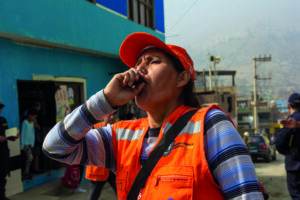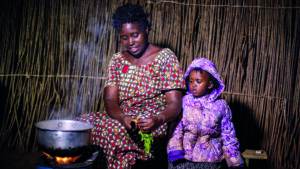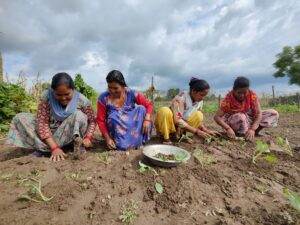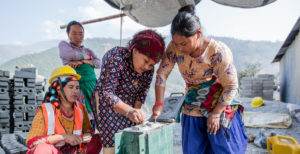Gender inequality
Across the world, gender inequality continues to be widespread and deep rooted. While there has been some progress, the statistics demonstrate stark inequalities. Globally, more women and girls live in extreme poverty than men and boys. In 2023, an estimated 309.6 million females live below the poverty line compared to 292 million males[i]. At work, women continue to be underrepresented in professional leadership roles. At the current rate of progress, it will take over 200 years to close the gender gap in economic opportunity[ii].
In the home, the distribution of domestic duties continues to be weighted towards women and girls. Many women living in developing countries risk their safety collecting fuel and water in isolated areas, using time which could be spent in education at work or for leisure or rest. Cooking duties also mean that a disproportionate number of women and girls are affected by unsafe stove emissions; indeed, air pollution is one of the leading causes of mortality among women globally[iii]. Finally, and most shockingly, one in three women have been subjected to physical, sexual or domestic violence.
Why focus on the rights of women and girls when addressing poverty?
Simply put, we all benefit from more equal societies. Gender equality is not a zero sum gain – nobody is worse off when women and girls have the opportunity to put their skills and knowledge to good use. Whether that’s in adopting and promoting regenerative agriculture practices that boost global food security whilst safeguarding our natural world, developing and sharing renewable energy solutions as part of the clean energy transition, actively participating in sanitation and waste governance and service delivery, or ensuring effective prevention and response measures to accelerating natural hazards – everyone is better off when gender equality in integrated throughout.
Gender inequality and poverty are intrinsically interlinked. In many of the countries where we work, women are sometimes paid less than half as much as their male counterparts when carrying out the same role. For example, a report stemming from our sanitation work in Bangladesh revealed salaries for women are 50% lower than those of men, despite doing exactly the same work. When it comes to farming and agriculture, women are responsible for a large part of our food production globally (60 – 80% of it in Sub-Saharan Africa[iv]). Despite this, women and girls sadly face higher levels of hunger and malnutrition. On average, 10% more women than men face moderate or severe levels of food insecurity. In Latin America and the Caribbean, shockingly this discrepancy rises to 30%[v].
Addressing gender inequality is absolutely imperative to any sustainable development initiative. Whatever the reasons for these entrenched injustices, we believe that everyone should have the opportunities, resources and support to achieve their potential.

Deborah blows a whistle during a disaster resilience training exercise. She volunteers in the local ‘brigade’, helping to give her community vital early warnings in the face of destructive floods and landslides.
Women’s Key role in Climate Change adaptation
Gender inequalities also intersect with climate justice. When climate-change induced natural hazards strike, existing inequalities become exacerbated. Women and girls are starting off on the back foot, so the impacts of extreme (but increasingly common) events such as floods, droughts or landslides are unfortunately not uniform.
To give some examples, in the wake of Cyclone Nargis in Myanmar in 2008, 61% of fatalities were women. In 2004, 70% of the people killed by the Asian Tsunami were women. Why is this the case?
Barriers to accessing information flows and technology can result in women struggling to receive vital warnings when disasters are predicted. In many contexts, women are also left behind to help children and the elderly to reach safety, but yet they are all too often overlooked in rescue volunteer groups and disaster preparedness training.
At Practical Action, our disaster resilience team work hard to create more inclusive early warning systems for floods, notably in Nepal, Peru, Senegal, Niger (to come), Bangladesh and Bolivia. These systems ensure the needs of women and girls, and other vulnerable groups, are considered throughout the whole design process, as well as empowering women in protecting their communities.
In addition, we research these issues through an intersectional gender lens. Our report entitled, ‘Missing Voices’, explores the experiences of marginalised groups in early warning systems in Nepal and Peru, including those of cisgender women, disabled women, single mothers, elderly women, adolescent girls, and transgender women and men, and non-binary people.
How is Practical Action working to empower women and girls?
Addressing gender inequality and women’s empowerment is fundamental to everything we do at Practical Action. We are committed to understanding how systems can be transformed to better support women’s needs and well-being, respond to their priorities and promote gender equality. We also work with men, constructively engaging them to challenge assumptions, prejudices, and behaviours.
Here are some examples:
Women at work
Most of the farmers in the communities where we work are women; in fact, nearly half of the world’s farmers are women. But they lack access to markets, technology, finance and often do not own the land.
In Kenya, we’re addressing this through a training and support programme for young people in rural areas, many of whom would typically emigrate to cities to search for work. There is a strong gender inclusivity element to this project, encouraging young women to see farming as a viable income source, and training them to mentor other young women on regenerative agriculture techniques.
In one of the cities where we work in Bangladesh, we secured an agreement from the local council to pay women and men the same salaries. This is an incredible achievement and a great start to changing gender norms in the region.
Women at home
In Kenya, and also in the Rwandan refugee camps where we work, our clean energy programme has helped over one million individuals experience the benefits of cleaner cooking stoves. These stoves reduce the harmful emissions which women inhale when cooking, and they also reduce time spent collecting firewood.
In Odisha, India, Practical Action’s ‘Sunolo Sakhi’ programme (‘Sister, let’s listen’) has challenged taboos around menstruation and improved access to health information and advice for adolescent girls. With adequate sanitary protection, young women can participate more fully in education and work opportunities.

Gentille purchased a clean cookstove through the Renewable Energy for Refugees project in Rwanda. The reduced smoke emitted means her family’s health has improved. She can also cook a lot faster, giving her more time with her children.
What is Gender Transformative Change?
We believe that gender transformative change is fundamental to creating a world that works better for everyone. When women and men enjoy equal opportunities to work, to participate in decision-making, to lead and to thrive, everyone benefits
Every time we initiate a new piece of work, we ask ourselves (and our partners): ‘Are we going to preserve existing gender inequalities with this intervention or are we going to contribute to real change?’
To ensure that gender equality is integrated throughout, we make sure women and other excluded groups are meaningfully consulted and included from the outset. We continue this involvement through the project design stage, during implementation, and when evaluating the project’s impact. We consistently and strategically aim to challenge the status quo in terms of women’s access to resources, services, opportunities and rights. Women and excluded groups are supported to articulate their own priorities to decision makers. We provide the forums, but then step back and give space for these voices to speak for themselves.
Internally – 70% of our Global Leadership Team are women, led by a woman CEO. We have Gender Focal Points in all offices and an active Global Gender Group that shares learning and experiences across the organisation.
We believe that nothing is gender-neutral. Gender transformative approaches promote women’s empowerment by exploring and transforming the deeper issues, like who controls resources, equal wages, political representation, legal entitlement to land, and the day-today distribution of household tasks. As Alicia Quezada, our Regional Director in Latin America, elegantly captured it: “gender equality is development”.
[i] World Poverty Clock (figure taken in June 2023), World Data Lab, World Poverty Clock.
[ii] Human Development Report 2019. Beyond income, beyond averages, beyond today: Inequalities in human development in the 21st century. Pg.147. Available here.
[iii] Household air pollution (who.int)
[iv] Gender Food Security report, FAO, Gender food security (fao.org).
[v] Gender Food Security report, FAO, Gender food security (fao.org).

